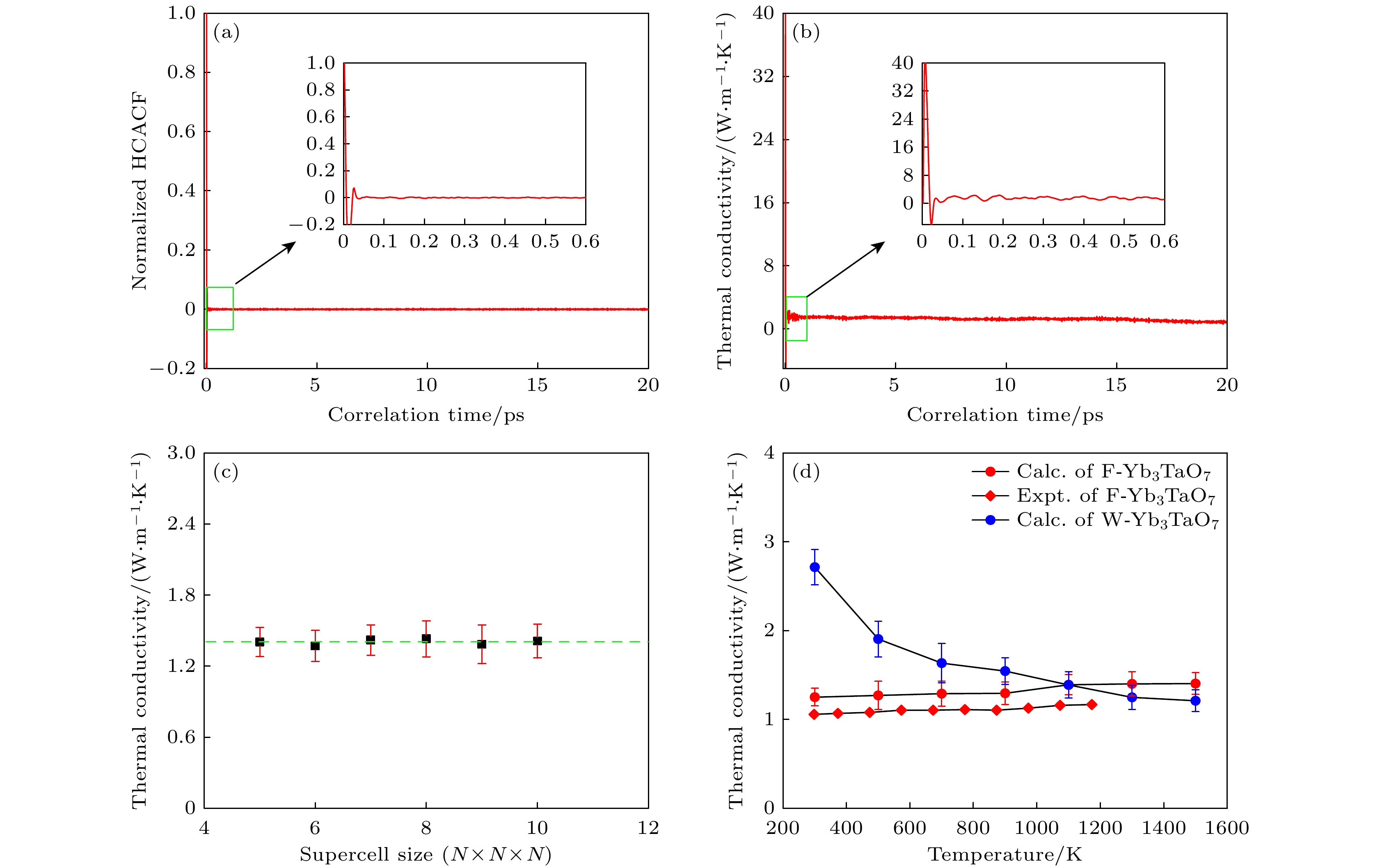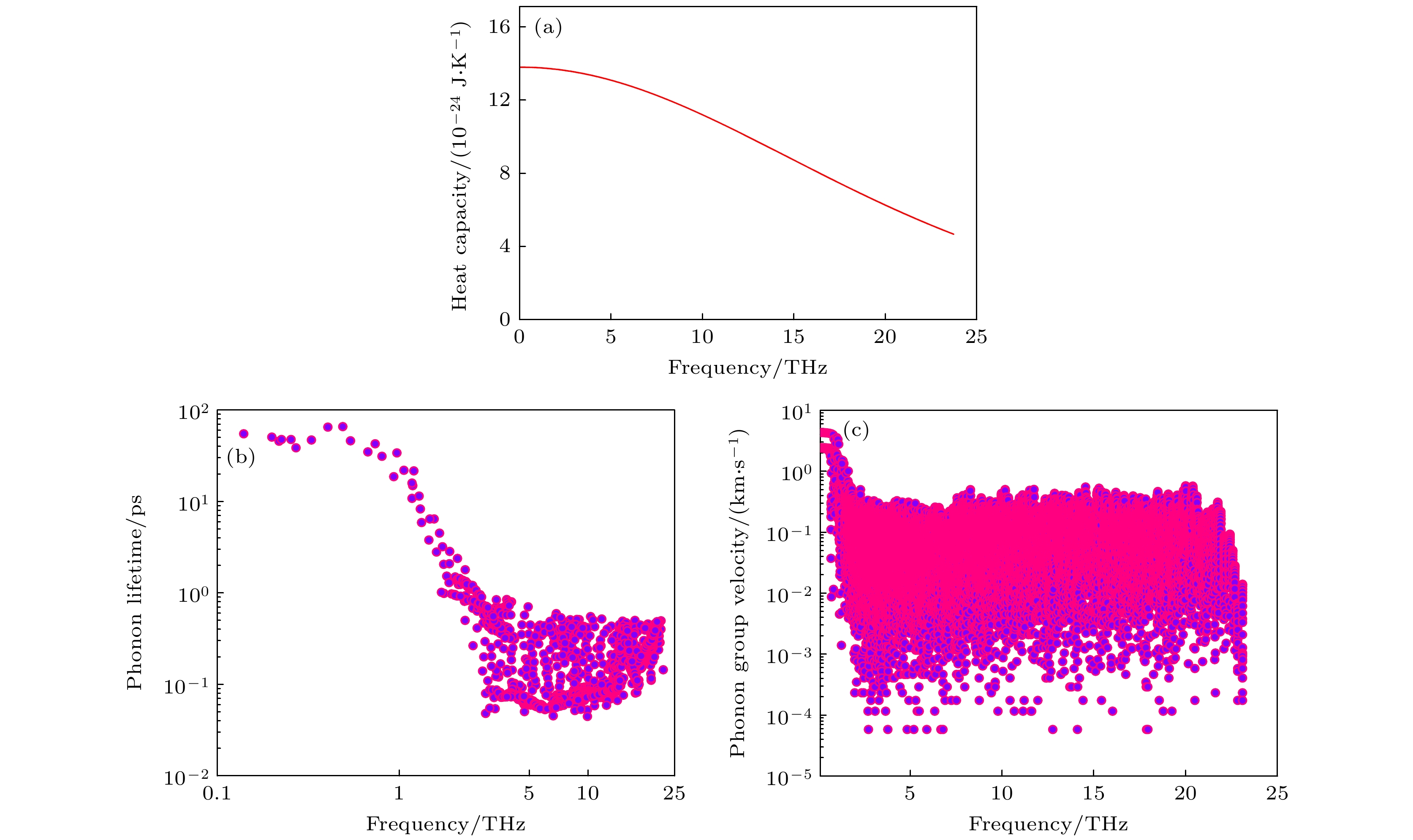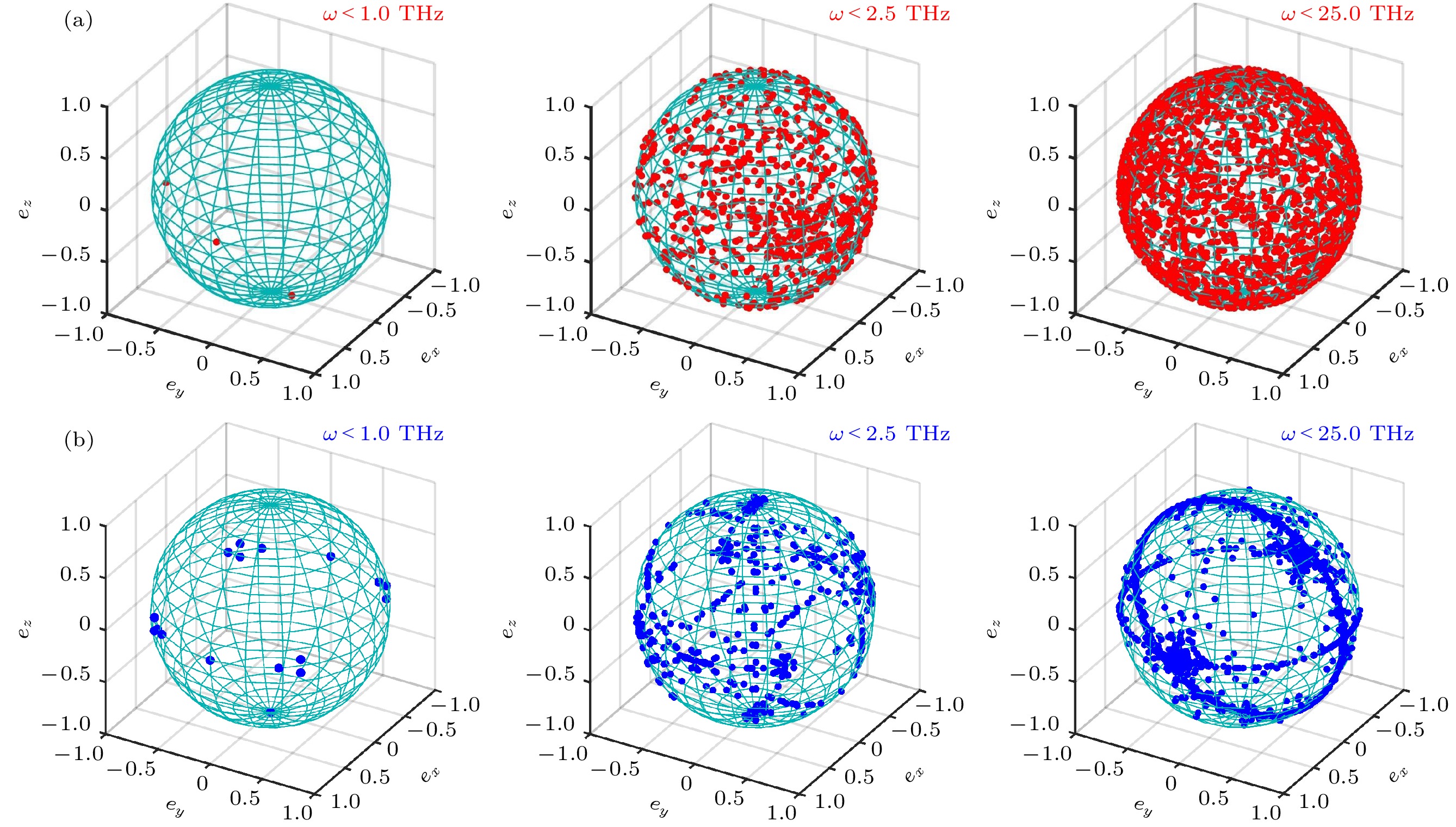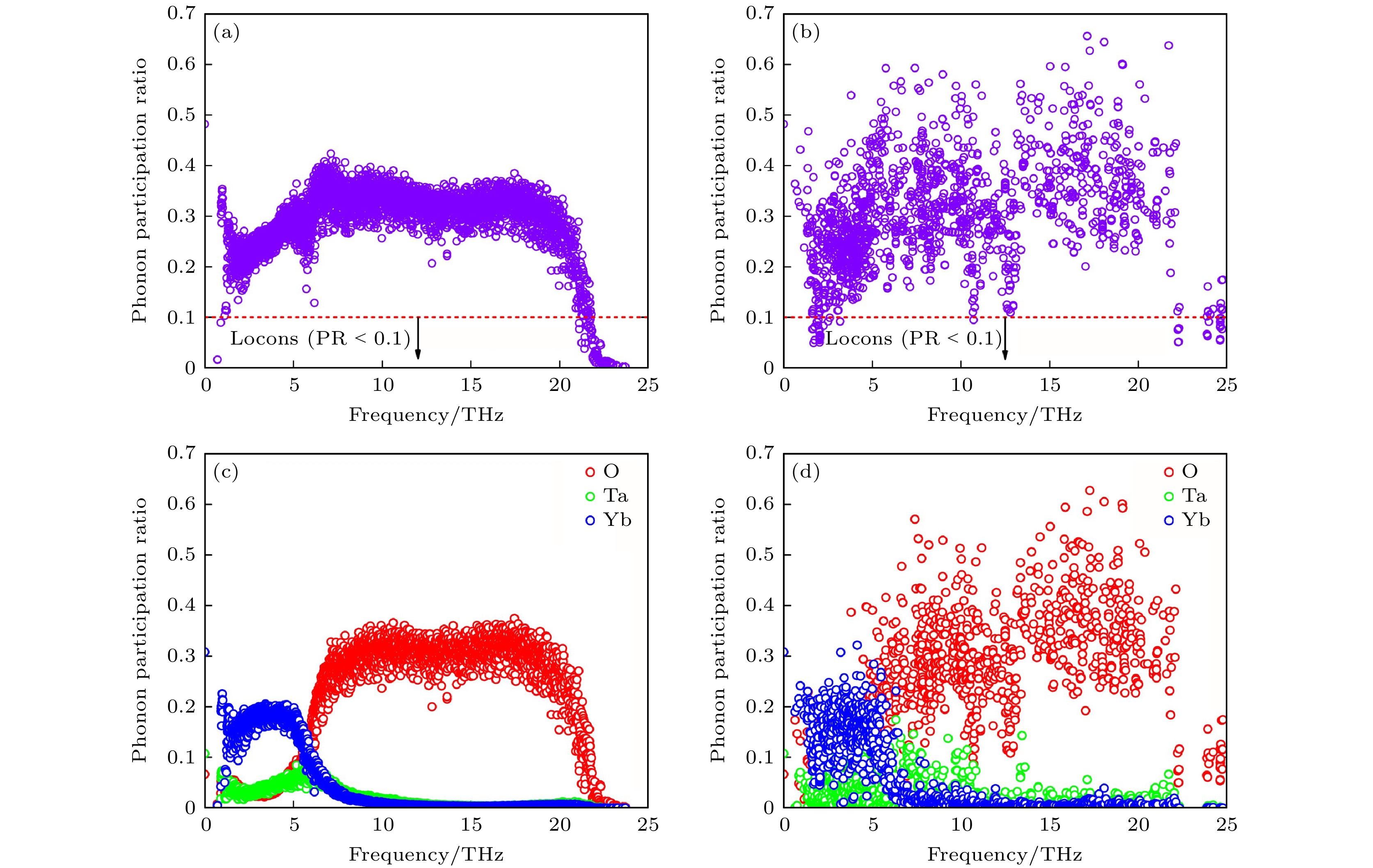-
具有非晶状热导率的固体材料在热能转换和热管理应用中备受青睐. 因此, 揭示晶体材料的非晶状热传导机理对于开发和设计低热导率材料至关重要. 本文运用原子模拟方法揭示了萤石结构二元简单晶体Yb3TaO7的非晶状低热导率的物理机理. 研究发现, 萤石Yb3TaO7的低热导率主要是由O-Yb和O-Ta之间的原子间结合力相差较大引起的. 这种相差较大的原子键可以极大地软化声子模式, 从而抑制声子输运. 振动模式分解显示, 萤石Yb3TaO7中的大多数声子模式位于Ioffe-Regel极限以下, 表现出强烈的扩散特征. 萤石Yb3TaO7中绝大部分(> 90%)的热流是通过扩散模式而不是传播模式传输. 因此, 萤石Yb3TaO7中的热传导表现出独特的类非晶特性. 同时发现, 萤石Yb3TaO7中的光学声子模式在热传导中发挥着重要的作用. 本文对于原子间结合力与低热导率之间关系的认识, 以及开发和设计低热导率材料提供了新思路.The materials with low thermal conductivity (κ) are both fundamentally interesting and technologically important in applications relevant to thermal energy conversion and thermal management, such as thermoelectric conversion devices, thermal barrier coatings, and thermal storage. Therefore, understanding the physical mechanisms of glass-like heat conduction in crystalline materials is essential for the development and design of low-κ materials. In this work, the microscopic phonon mechanism of glass-like low κ in binary simple crystal Yb3TaO7 with fluorite structure is investigated by using the equilibrium molecular dynamics, phonon spectral energy density, and lattice dynamics. Meanwhile, the weberite-structured Yb3TaO7 is also mentioned for comparison. The calculated κ indicates that fluorite Yb3TaO7 has a glass-like low κ while weberite Yb3TaO7 has a crystal κ. Such a low κ in fluorite Yb3TaO7 is mainly due to the large difference in interatomic force between O-Yb and O-Ta. This different atomic bonding can significantly soften the phonon mode and thus limit phonon transport. To further describe the microscopic phonon thermal conduction, the single-channel model based on the phonon gas model is first used to calculate the total κ. However, the single-channel model significantly underestimates the κ, suggesting the presence of non-normal phonons in Yb3TaO7. Based on this, vibrational mode decomposition is conducted throughout the entire phonon spectrum of fluorite- and weberite-type Yb3TaO7. It is found that most modes in fluorite Yb3TaO7 fall in the Ioffe–Regel regime and exhibit a strongly diffusive nature. Such diffusive modes cannot be described by the phonon gas model. Based on the decomposed phonon modes, the dual-channel model involving diffusive mode and propagating mode is used to describe the phonon thermal conduction, by which the obtained results accord well with the experimental values. The vast majority (> 90%) of heat in fluorite Yb3TaO7 is found to be transported by diffusive modes rather than propagating modes. Consequently, the κ of fluorite Yb3TaO7 increases with temperature rising, exhibiting a unique glass-like nature. In particular, contrary to conventional wisdom, the optical phonon mode in fluorite Yb3TaO7 plays a significant or even decisive role in thermal conduction, which could serve as a new physical factor to adjust κ in solid materials. Overall, the new understanding of the link between chemical bonding and glass-like κ can contribute to the development and design of low-κ materials.
-
Keywords:
- glass-like thermal conductivity /
- phonon transport /
- diffusive phonons /
- thermal barrier coatings
[1] Padture N P, Gell M, Jordan E H 2002 Science 296 280
 Google Scholar
Google Scholar
[2] Wu J, Wei X, Padture N P, Klemens P G, Gell M, Garcia E, Miranzo P, Osendi M I 2003 Chem. Inform. 34 3031
[3] Schelling P K, Phillpot S R 2001 J. Am. Ceram. Soc. 84 2997
 Google Scholar
Google Scholar
[4] Zhu J, Meng X, Zhang P, Li Z, Xu J, Reece M J, Gao F 2021 J. Eur. Ceram. Soc. 41 2861
 Google Scholar
Google Scholar
[5] Chevalier J, Gremillard L, Virkar A V, Clarke D R 2009 J. Am. Ceram. Soc. 92 1901
 Google Scholar
Google Scholar
[6] Anupam A, Kottada R S, Kashyap S, Meghwal A, Murty B S, Berndt C C, Ang A S M 2020 Appl. Surf. Sci. 505 144117
 Google Scholar
Google Scholar
[7] 李世彬, 吴志明, 袁凯, 廖乃镘, 李伟, 蒋亚东 2008 物理学报 57 3126
 Google Scholar
Google Scholar
Li S B, Wu Z M, Yuan K, Liao N M, Li W, Jiang Y D 2008 Acta Phys. Sin. 57 3126
 Google Scholar
Google Scholar
[8] King G, Thompson C M, Greedanb J E, Llobet A 2013 J. Mater. Chem. A. 1 10487
 Google Scholar
Google Scholar
[9] Chen L, Hu M, Wu F, Song P, Feng J 2019 J. Alloys Compd. 788 1231
 Google Scholar
Google Scholar
[10] Schlichting K W, Padture N P, Klemens P G 2001 J. Mater. Sci. 36 3003
 Google Scholar
Google Scholar
[11] Zarichnyak Y P, Ramazanova A E, Emirov S N 2013 Phys. Solid State 55 2436
 Google Scholar
Google Scholar
[12] Stanek C R, Minervini L, Grimes R W 2002 J. Am. Ceram. Soc. 85 2792
 Google Scholar
Google Scholar
[13] Tealdi C, Islam M S, Malavasi L, Flor G 2004 J. Solid State Chem. 177 4359
 Google Scholar
Google Scholar
[14] 张智奇, 钱胜, 王瑞金, 朱泽飞 2019 物理学报 68 054401
 Google Scholar
Google Scholar
Zhang Z Q, Qian S, W R J, Zhu Z F 2019 Acta Phys. Sin. 68 054401
 Google Scholar
Google Scholar
[15] Thomas J A, Turney J E, Iutzi R M, Amon C H, McGaughey A J 2010 Phys. Rev. B 81 081411
 Google Scholar
Google Scholar
[16] Turney J E, Landry E S, McGaughey A J H, Amon C H 2009 Phys. Rev. B 79 064301
 Google Scholar
Google Scholar
[17] Su R, Yuan Z, Wang J, Zhang Z 2015 Phys. Rev. E 91 012136
 Google Scholar
Google Scholar
[18] Su R X, Yuan Z Q, Wang J, Zheng Z G 2016 Front. Phys. 11 114401
 Google Scholar
Google Scholar
[19] 郑翠红, 杨剑, 谢国锋, 周五星, 欧阳滔 2022 物理学报 71 056101
 Google Scholar
Google Scholar
Zheng C H, Yang J, Xie G F, Zhou W X, Ouyang T 2022 Acta Phys. Sin. 71 056101
 Google Scholar
Google Scholar
[20] Lee C H, Gan C K 2017 Phys. Rev. B 96 035105
 Google Scholar
Google Scholar
[21] Lü W, Henry A 2016 Sci. Rep. 6 35720
 Google Scholar
Google Scholar
[22] Yang B, Chen G 2003 Phys. Rev. B 67 195311
 Google Scholar
Google Scholar
[23] Dechaumphai E, Chen R 2012 J. Appl. Phys. 111 073508
 Google Scholar
Google Scholar
[24] Luo Y X, Yang X L, Feng T L, Wang J Y, Ruan X L 2020 Nat. Commun. 11 1
 Google Scholar
Google Scholar
[25] Kumar G, Vangessel F G, Elton D C, Chung P W 2019 MRS Adv. 4 2191
 Google Scholar
Google Scholar
[26] Seyf H R, Henry A 2016 J. Appl. Phys. 120 25101
 Google Scholar
Google Scholar
[27] Beltukov Y M, Kozub V I, Parshin D A 2013 Phys. Rev. B 87 134203
 Google Scholar
Google Scholar
[28] Allen P B, Feldman J L 1993 Phys. Rev. B 48 12581
 Google Scholar
Google Scholar
[29] Clarke D R 2003 Surf. Coat. Technol. 163 67
[30] Cahill D G, Watson S K, Pohl R O 1992 Phys. Rev. B 46 6131
 Google Scholar
Google Scholar
[31] Morelli D T, Heremans J P, Slack G A 2002 Phys. Rev. B 66 195304
 Google Scholar
Google Scholar
[32] Slack G A 1973 J. Phys. Chem. Solids 34 321
 Google Scholar
Google Scholar
-
图 2 1500 K温度下的热导率计算结果 (a) 归一化热流关联函数随关联时间的变化关系; (b) 热导率随关联时间的变化关系; (c) 不同超胞的热导率; (d) 热导率随温度的变化关系
Fig. 2. Calculated thermal conductivity at 1500 K: (a) Normalized HCACF versus correlation time; (2) thermal conductivity versus correlation time; (c) calculated thermal conductivity with different supercell; (d) temperature dependence of thermal conductivity.
原子间作用 A/eV ρ/Å C/(eV·Å6) O—O 9547.96 0.2192 32.00 O—Ta 1315.57 0.3690 0 O—Yb 1649.80 0.3386 16.57 表 2 计算的La2Zr2O7和Yb3TaO7的晶格常数、格林艾森常数和弹性模量
Table 2. Calculated lattice constants, Grüneisen constants, and elastic modulus for La2Zr2O7 and Yb3TaO7.
-
[1] Padture N P, Gell M, Jordan E H 2002 Science 296 280
 Google Scholar
Google Scholar
[2] Wu J, Wei X, Padture N P, Klemens P G, Gell M, Garcia E, Miranzo P, Osendi M I 2003 Chem. Inform. 34 3031
[3] Schelling P K, Phillpot S R 2001 J. Am. Ceram. Soc. 84 2997
 Google Scholar
Google Scholar
[4] Zhu J, Meng X, Zhang P, Li Z, Xu J, Reece M J, Gao F 2021 J. Eur. Ceram. Soc. 41 2861
 Google Scholar
Google Scholar
[5] Chevalier J, Gremillard L, Virkar A V, Clarke D R 2009 J. Am. Ceram. Soc. 92 1901
 Google Scholar
Google Scholar
[6] Anupam A, Kottada R S, Kashyap S, Meghwal A, Murty B S, Berndt C C, Ang A S M 2020 Appl. Surf. Sci. 505 144117
 Google Scholar
Google Scholar
[7] 李世彬, 吴志明, 袁凯, 廖乃镘, 李伟, 蒋亚东 2008 物理学报 57 3126
 Google Scholar
Google Scholar
Li S B, Wu Z M, Yuan K, Liao N M, Li W, Jiang Y D 2008 Acta Phys. Sin. 57 3126
 Google Scholar
Google Scholar
[8] King G, Thompson C M, Greedanb J E, Llobet A 2013 J. Mater. Chem. A. 1 10487
 Google Scholar
Google Scholar
[9] Chen L, Hu M, Wu F, Song P, Feng J 2019 J. Alloys Compd. 788 1231
 Google Scholar
Google Scholar
[10] Schlichting K W, Padture N P, Klemens P G 2001 J. Mater. Sci. 36 3003
 Google Scholar
Google Scholar
[11] Zarichnyak Y P, Ramazanova A E, Emirov S N 2013 Phys. Solid State 55 2436
 Google Scholar
Google Scholar
[12] Stanek C R, Minervini L, Grimes R W 2002 J. Am. Ceram. Soc. 85 2792
 Google Scholar
Google Scholar
[13] Tealdi C, Islam M S, Malavasi L, Flor G 2004 J. Solid State Chem. 177 4359
 Google Scholar
Google Scholar
[14] 张智奇, 钱胜, 王瑞金, 朱泽飞 2019 物理学报 68 054401
 Google Scholar
Google Scholar
Zhang Z Q, Qian S, W R J, Zhu Z F 2019 Acta Phys. Sin. 68 054401
 Google Scholar
Google Scholar
[15] Thomas J A, Turney J E, Iutzi R M, Amon C H, McGaughey A J 2010 Phys. Rev. B 81 081411
 Google Scholar
Google Scholar
[16] Turney J E, Landry E S, McGaughey A J H, Amon C H 2009 Phys. Rev. B 79 064301
 Google Scholar
Google Scholar
[17] Su R, Yuan Z, Wang J, Zhang Z 2015 Phys. Rev. E 91 012136
 Google Scholar
Google Scholar
[18] Su R X, Yuan Z Q, Wang J, Zheng Z G 2016 Front. Phys. 11 114401
 Google Scholar
Google Scholar
[19] 郑翠红, 杨剑, 谢国锋, 周五星, 欧阳滔 2022 物理学报 71 056101
 Google Scholar
Google Scholar
Zheng C H, Yang J, Xie G F, Zhou W X, Ouyang T 2022 Acta Phys. Sin. 71 056101
 Google Scholar
Google Scholar
[20] Lee C H, Gan C K 2017 Phys. Rev. B 96 035105
 Google Scholar
Google Scholar
[21] Lü W, Henry A 2016 Sci. Rep. 6 35720
 Google Scholar
Google Scholar
[22] Yang B, Chen G 2003 Phys. Rev. B 67 195311
 Google Scholar
Google Scholar
[23] Dechaumphai E, Chen R 2012 J. Appl. Phys. 111 073508
 Google Scholar
Google Scholar
[24] Luo Y X, Yang X L, Feng T L, Wang J Y, Ruan X L 2020 Nat. Commun. 11 1
 Google Scholar
Google Scholar
[25] Kumar G, Vangessel F G, Elton D C, Chung P W 2019 MRS Adv. 4 2191
 Google Scholar
Google Scholar
[26] Seyf H R, Henry A 2016 J. Appl. Phys. 120 25101
 Google Scholar
Google Scholar
[27] Beltukov Y M, Kozub V I, Parshin D A 2013 Phys. Rev. B 87 134203
 Google Scholar
Google Scholar
[28] Allen P B, Feldman J L 1993 Phys. Rev. B 48 12581
 Google Scholar
Google Scholar
[29] Clarke D R 2003 Surf. Coat. Technol. 163 67
[30] Cahill D G, Watson S K, Pohl R O 1992 Phys. Rev. B 46 6131
 Google Scholar
Google Scholar
[31] Morelli D T, Heremans J P, Slack G A 2002 Phys. Rev. B 66 195304
 Google Scholar
Google Scholar
[32] Slack G A 1973 J. Phys. Chem. Solids 34 321
 Google Scholar
Google Scholar
计量
- 文章访问数: 7442
- PDF下载量: 98
- 被引次数: 0
















 下载:
下载:







